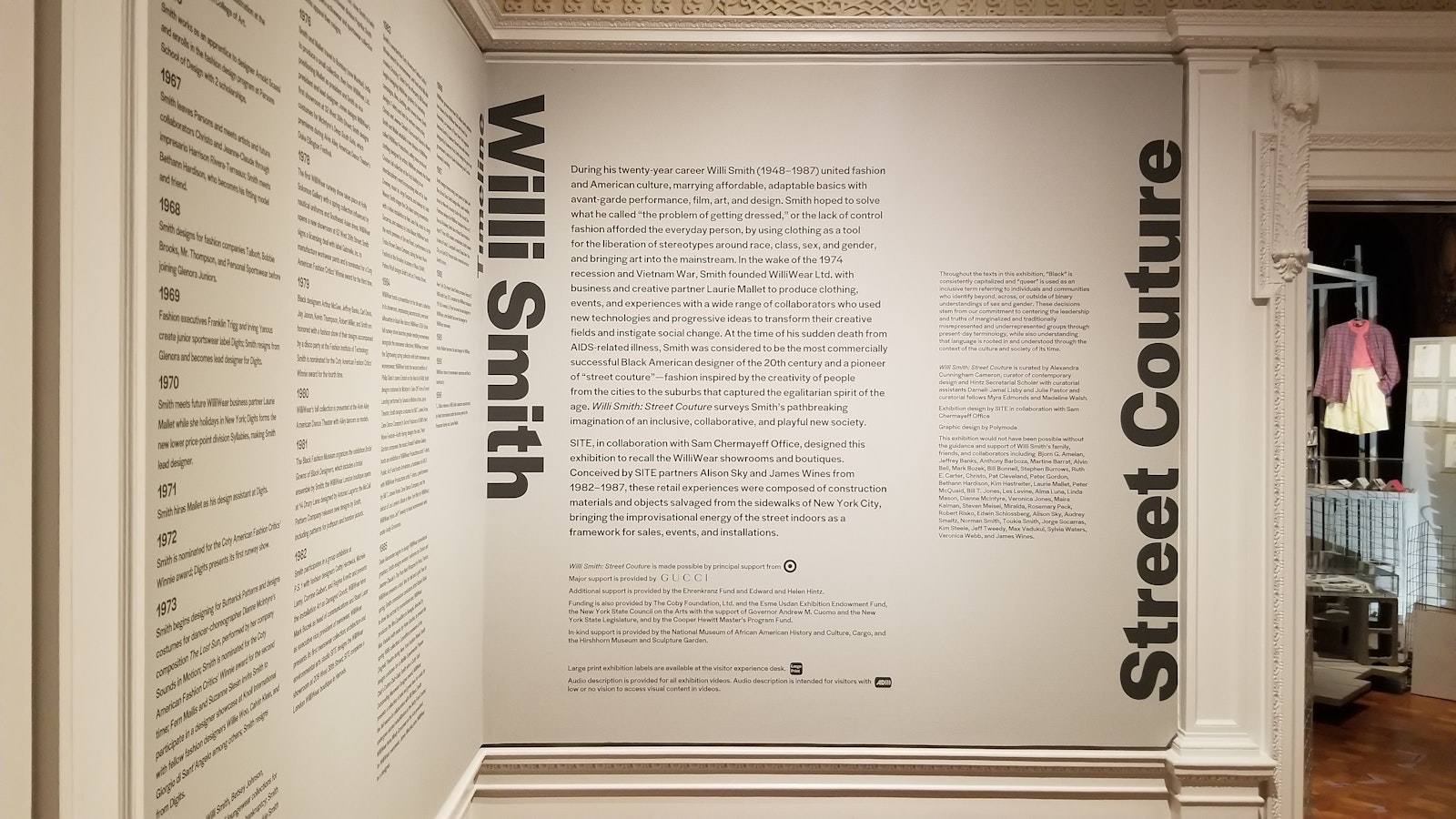In March 2020, Cooper Hewitt, Smithsonian Design Museum opened Willi Smith: Street Couture, the first museum survey of the work of American designer Willi Smith (1948–1987). Through more than two hundred of the artist’s works across a range of media, the exhibition illuminates the pathbreaking imagination of an under-recognized pioneer of streetwear fashion—one who played an important role in the New York art scene of the 1970s and 1980s and was heralded as “the most successful black designer in history” by New York Daily News before his sudden death, in 1987, of AIDS-related complications. As evidence of fashion’s potential to break down cultural and social boundaries, the galleries collectively trace the evolution of Smith’s designs through his extensive collaborations with visual and performing artists, architects, and media vanguard. Smith’s work emerges not only as an expression of the sociopolitical, economic, and artistic transformation of his time, but also as a catalyst in the reimagining of fashion—from a siloed discipline reinforcing class, race, and gender divides, toward an experience and lifestyle-driven industry that creates a space of play and indeterminacy.
Our team was tasked with designing the catalogue, collaborating on the exhibition design, designing the didactics, and design direction of the community archive. Each project ran concurrently, offering us the opportunity to help develop not only the look and feel of the show’s identity, but also explore the ways in which we could conceptualize a historical publication within the expressive, editorial environment of the fashion industry.
Conceptually, the identity comprises a set of fundamental elements: verticality; Smith’s cutting-edge designs; the ghosting of memory and the collective loss of potential mentors to AIDS (as expressed by the grey tones); New York’s architecture and broad avenues; and the proportions of the standing, human body. This theme flows seamlessly through all forms of the identity’s typography—from the catalogue’s front matter, to the headlines displayed throughout the galleries, and other related exhibition content. Also incorporating the design identity is the web archive launched by Cooper Hewitt to house stories submitted by members of the public who remember and have documentation of Willi Smith, his collaborations, and his creations.
Smith celebrated his Blackness and embraced his queerness—working with a spirit of utilitarian accessibility in the design of his clothes while transcending the trappings of socially constructed identity. In the process of selecting typography for the exhibition, we felt it was important to find a type designer and type family that could speak to both a queer Black lineage and the no-nonsense practicality of WilliWear’s separates. We found this in the Halyard typeface, conceptualized by Joshua Darden in collaboration with Eben Sorkin and Lucas Sharp and released by Darden Studio in 2017.
Halyard Display creates a bold graphic statement that we believe would have pleased Smith, who once remarked to Women’s Wear Daily, “I hate to see good clothes displayed in a non-special way, without saying anything.” The companion Halyard Text is drawn as a “workhorse” typeface; it functions well at smaller point sizes and supports extended reading of the deep research and moving memories archived in the book.
Designing the exhibition within the historical landmark of the museum’s building, the famed Carnegie Mansion, comes with certain limitations but also contrasting design solutions. Conceptually, the curatorial team envisioned adapting the look and feel of Smith’s flagship store on 200 Fifth Avenue, which was designed by James Wines of SITE Architects. The design direction brings the literal, monotone greyness of the city, and built that urban landscape inside the store. This renders the clothing in stark contrast to the toned backdrop of deconstructed elements of New York City—particularly from the Christopher Street piers that Smith would frequent. Metaphorically the grey tones also speak to Smith as a ghost emerging into visibility in the discourses of art, design, and fashion.
The flow of the exhibition takes a view on a journey through a streetscape organized by the varied bodies of work created by Smith that include runway shows, film and video, dance, performance art, street wear and multiple forms of design. Architectural openings in sections allow the eye to both focus and wander to see the overlaps and connections across the range of Smith’s work.
We was responsible for all levels of didactics, A-, B-, and C-level graphics (read: title wall, timeline, headlines, subheads, and object captions: 62 pieces in total). This required tight collaboration with Sam Chermayeff and Betsy Clifton to arrange not only the fashion pieces by Smith, but also the posters, and other ephemera. All–while not being able to touch the original walls of the mansion.
After nine months of collaboration with a complex team—including exhibition curator Alexandra Cunningham Cameron, James Wines of SITE architects, Sam Chermayeff Architects, and many internal teams at the museum—the public opening of Willi Smith: Street Couture was indefinitely postponed one day prior due to COVID-19 and the resulting closures of all cultural spaces in New York City. There was only a press preview and one day of private access. To connect their audiences to the exhibition during the museum's temporary closure, the Cooper Hewitt greatly expanded the digital archive of the show. Ahead of an eventual reopening, we continue to work with the museum’s teams to redesign the interactive elements of the exhibition in order to protect and ensure the health and safety of all visitors during the ongoing pandemic.
- Graphic Designer
- Silas Munro
- Graphic Designer
- Brian Johnson
- Graphic Designer
- Michelle Lamb
- Curator
- Alexandra Cunningham Cameron
- Head of Exhibitions
- Yvonne Gómez
- Exhibitions Coordinator
- Molly Engelman
- Architect
- Betsy Clifton
- Architect
- Sam Chermayeff
- Architect
- James Wines











